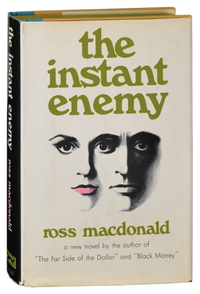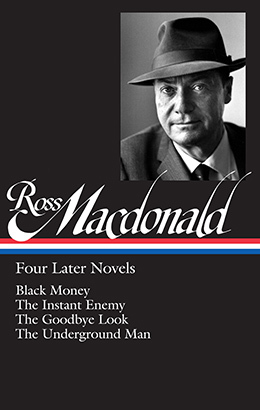Library of America’s Ross Macdonald edition concludes this summer with Ross Macdonald: Four Later Novels, a collection of four Lew Archer mysteries from late 1960s and early ’70s. Volume editor Tom Nolan is providing a series of critical commentaries on each of the books in Four Later Novels, and continues now with a look at the autobiographical elements lurking in 1968’s The Instant Enemy, in which Macdonald took his penchant for baroque plotting to a dizzying new extreme.
By Tom Nolan
In May 1966, Ross Macdonald wrote to his publisher Alfred A. Knopf acknowledging an ad Knopf had placed in the New York Times for Macdonald’s most recent novel, Black Money. “I think your ad is perfect, beautifully done and timed,” he told Knopf. “Its effect on me was to make me want to get started on another book.”
That book would be The Instant Enemy (1968), an absorbing, swift-reading chronicle culminating in arguably the most complicated solution of any of Macdonald’s always complex novels.
Its opening sequence takes place in “an angular contemporary house cantilevered out over a slope” overlooking a Woodland Hills golf course—the home of a couple whose seventeen-year-old daughter has apparently run away, taking her father’s shotgun. Macdonald based the setting on the house of a college-teacher friend, Richard Lid, and his wife Betty.
“We had a house on five levels, over in Woodland Hills, above the country club,” Lid said in 1990. The story Macdonald spun from this initial scene was nearly on five levels itself: a saga that extended the premise of the California Dream to near-surreal extremes. In The Instant Enemy, certain people go so far in “reinventing” themselves that they switch identities—“becoming” each other.
The Lids had lived in Santa Barbara in the late 1950s and been close to the Millars then. Dick Lid drove Ken Millar on a tense near-thousand-mile round-trip to and from Bishop, California, to reunite with the Millars’ then-nineteen-year-old daughter Linda after her ten-day disappearance in 1959 from her UC Davis campus. The Lids had been privy to the Millars’ most personal travails. It was during a Millar family gathering at the Lids’ Woodland Hills house in 1967 that Ross Macdonald asked to borrow the Lids’ Morro Drive split-level for his book-in-progress.
“Linda [and her husband were] living in Long Beach,” Betty Lid recalled in 1990. “It was a Saturday morning when she came with her child. . . . [She and Ken] had been up in the canyon, to see more sights for the novel, driving around for landscapes . . . [Our son] Adam was six . . . He was trying to take care of [Linda’s son Jimmie], who was two and a half or three.” The Lids were glad to see Linda looking happy and doing well. So was her father: “Perhaps I’ll never work as hard, quite, as I have in the last ten years, paying off the bloody medical bills,” he wrote an old university colleague in Michigan. “Lin’s in good shape now.”
From this secure-seeming vantage-point, Macdonald chose to submerge himself in a story dense with concealed references to his own and his daughter’s troubled pasts. Once again the author mined memory—working, he said, not with realistic images of his own relatives but with “representations of family forces”—for events and emotions that would give this fiction personal meaning in ways readers would know nothing of yet be moved by nonetheless.

Linda was represented in The Instant Enemy by Sandy Sebastian, the vanished daughter whose grievances against her parents and others are all too vivid and whose previous behavior had seemed disturbing enough. “She used to talk about suicide all the time,” Sandy’s best girlfriend tells Lew Archer. “She was going to walk into the ocean at Zuma Beach and swim on out.” Linda Millar had half-heartedly attempted suicide (by slitting her wrists) in 1956, after her involvement in a fatal hit-and-run accident; and her long ocean swims around that time often alarmed those who’d witnessed them, including Dick Lid.
In the novel, the fictional and psychological surrogate for Millar/Macdonald was Davy Spanner, the angry delinquent whose impulse to lash out at the world is an exaggerated extension of Ken Millar’s youthful alienation. “Davy is a self-portrait,” Macdonald told Paul Nelson. “I don’t mean an accurate portrait, but a suppose portrait. The whole movement of the book is, in a remote but true sense, autobiographical.”
Grittier in style and detail than his earlier “autobiographical” book The Galton Case (1959), Enemy was a cautionary novel, its author said: “To show the tragic consequences of mistakes and human errors is a very positive thing to do. . . . You’re not . . . dwelling on evil, but really showing the consequences of it—and, by implication, how . . . we avoid it. In other words, I think it’s a healthy book.”
Nevertheless, cautionary tales by their nature contain dire turns.
To Steven Carter, a grad student writing his dissertation on Ross Macdonald’s work, the author wrote in 1968: “I must comment on . . . your shock at the revelation that love, and especially self-consciously ‘helping’ love, can be ambivalent and even destructive. . . . I fed in the evidence of [Davy’s would be-savior’s] sickness very lightly in the notion that he had a three-way [sexual] fantasy . . . The fantasy broke in violence, as fantasies do, violence being the ultimate hideaway of unreality. I’m glad you were shocked. Davy was my poor little tragic hero. [His would be-savior] suffers tragedy, too, so far as his nerves can sustain it.”
The most shocking event recounted in The Instant Enemy, perhaps, involves a man decapitated by a train: an occurrence the author told Nelson was “what the book is all about. . . . The killing of the father, in both its philosophic and narrative sense, is . . . the consequence of past troubles and the cause of future ones. It’s central.” (The Galton Case featured a decapitated skeleton, too: another beheaded father in another psychologically headless household.)
As to where the image may have originated in Macdonald’s imagination or memory, he implied to Nelson it may have come from the Tolstoy novel Resurrection. But to a documentary filmmaker, he had suggested a different source: “[As a child] in Wiarton, Ontario, I saw some thrilling serials, including . . . Pearl White’s Plunder. . . . These experiences probably had a great deal to do with the cinematic elements of my style. There is a scene in The Instant Enemy, for example, which could have been the climax of an episode in any cliff-hanger.”
Equally plausible inspirations for this grisly turn are two incidents closer to the writer’s personal experience (or “representation of family forces”). His wife Margaret’s brother Ross (sic) had been found dead in a rail yard in Canada, apparently having fallen off the top of a moving train. And in 1955, a year before her own auto accident, Linda Millar wrote her father (back east at the time) about recent Santa Barbara car crashes involving teenage drivers, the worst of which culminated with a boy she knew from school being decapitated by a moving train.
 |
| The Ross Macdonald Collection (3-volume boxed set) |
With its many shocking incidents and its multiply-entangled cast, and its tracing of the corrosive effects of so many vile deeds and strange secrets, Enemy had a great many plot lines to untangle at its denouement. Critic John M. Murte would write: “In The Instant Enemy . . . the long-hidden familial relationships are so incredibly interconnected that the extended revelation at the end is very nearly a parody of other Macdonald novels.” The author acknowledged that the complexity of Enemy had gotten a bit out of hand—“probably,” he told Paul Nelson, “because I was cutting very close to home in writing that book.”
As “close to home” for Macdonald as any of the book’s scenes was one coming halfway through Enemy in a rundown hotel in San Francisco’s Mission District. Here Lew Archer encounters a broken-down old prospector and fisherman named Albert Blevins, who Macdonald said was an intended portrait of his own father, the ex-newspaper editor, ex-tugboat captain, and one-time silver-miner John Macdonald Millar:
He wasn’t terribly old, but his body was warped by use and his seamed face was set in the cast of permanent stubborn failure. His clear blue eyes had the oddly innocent look of a man who had never been completely broken in to human society. You used to see such men in the small towns, in the desert, on the road. Now they collected in the hollow core of the cities.
Blevins gives Archer what the detective seeks: an account of his family life and history—a confession of his sins, in effect (“Marrying her was the big mistake of my life. I never should of married any woman. She told me that herself a hundred times, after we got hitched”)—and then Archer leaves him. “Our hands touched as he gave the picture back to me. I felt a kind of short-circuit, a buzzing and burning, as if I had grounded the present in the actual flesh of the past.”
Once again, Ross Macdonald had combined bits of his own history with imagination and sensibility, to contain and resolve past and present in a fictional catharsis both archetypal and unique.
“Time blurred like tears for an instant.”




